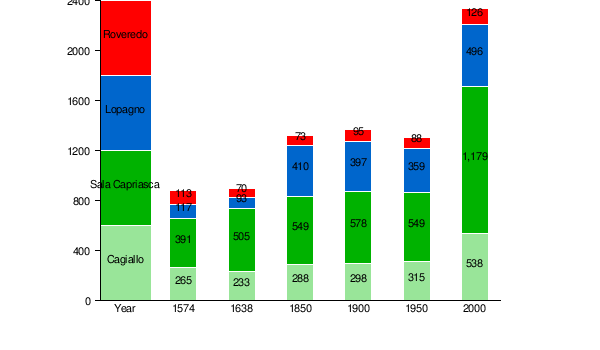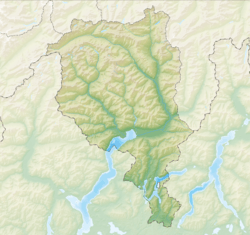Capriasca facts for kids
Quick facts for kids
Capriasca
|
||
|---|---|---|
|
||
| Country | Switzerland | |
| Canton | Ticino | |
| District | Lugano | |
| Area | ||
| • Total | 36.38 km2 (14.05 sq mi) | |
| Elevation | 529 m (1,736 ft) | |
| Population
(Dec 2020 )
|
||
| • Total | 6,755 | |
| • Density | 185.68/km2 (480.91/sq mi) | |
| Postal code |
6950
|
|
| Localities | Cagiallo, Sarone, Almatro, Bettagno, Bidogno, San Matteo-Muralta, Lopagno, Lugaggia, Treggia, Somazzo, Oggio, Roveredo, Sala Capriasca, Tesserete, Vaglio | |
| Surrounded by | Comano, Isone, Lugano, Mezzovico-Vira, Monteceneri, Origlio, Ponte Capriasca. | |
Capriasca is a town, also called a municipality, located in the Lugano area of the canton of Ticino in Switzerland. It was formed in 2001 when several smaller towns joined together. These towns were Cagiallo, Lopagno, Roveredo, Sala Capriasca, Tesserete, and Vaglio.
Contents
History of Capriasca
Capriasca has a long history, with its towns being mentioned centuries ago. For example, Cagiallo was first written about in the 1200s. Sala Capriasca was known even earlier, around 1078. Lopagno and Roveredo also have histories going back many hundreds of years.
Cagiallo's Past
For a long time, Cagiallo, along with Lopagno and Campestro, shared common land and resources. This was a special type of community called a Bürgergemeinde, which means "citizens' community."
The old church of S. Matteo was rebuilt in 1672, but its bell tower is much older, from the Romanesque period. People in Cagiallo used to make a living from farming and by moving to other places for work. Today, Cagiallo is like a part of the nearby town of Tesserete, helping with its tourism.
Sala Capriasca's Story
Sala Capriasca was once a Lombard village with protective walls. In the 1400s, it shared resources with Bigorio, similar to a Vicinanza (a neighborhood community). The main church, St. Anthony, was first mentioned in 1413 and was rebuilt later. The first Capuchin monastery in Switzerland was founded here in 1535.
In the past, people in Sala Capriasca mostly farmed and made things by hand. They also earned money by moving their animals to different pastures during the year. More recently, it has become a place where people live but travel to other towns, especially Lugano, for work.
Lopagno Through Time
Lopagno also shared a Vicinanza with Cagiallo and Campestro since the Middle Ages. In the 1500s and 1600s, many people left Lopagno to find work elsewhere. The town's economy was based on farming, trading, and building. In 1802, people from Lopagno were part of a protest against the government. Since 1952, there has been a special center in Lopagno called the Institute Don Orione, which helps people with mental disabilities.
Most people living in Lopagno today work outside the village.
Roveredo's History
Roveredo was part of the larger Capriasca area and the Tesserete church district. Its local chapel, St. Bernard of Clairvaux, was built in 1403.
Long ago, farming and raising animals were the main ways people earned money in Roveredo. Since the 1960s, it has grown into a place where people live and travel to nearby Lugano and Tesserete for their jobs. Most workers in Roveredo now commute.
Geography of Capriasca
Capriasca covers an area of about 36.35 square kilometers (about 14 square miles). A small part of this land, about 1%, is used for farming. A larger part, almost 6%, is covered by forests. About 1% of the land has buildings or roads, and a very small amount is unproductive land.
The village of Cagiallo includes smaller areas like Sarone and Almatro. Sala Capriasca is in the Capriasca valley, near Mount Bigorio, and includes areas like Bigorio and Lelgio. Lopagno is also in the Capriasca valley and has small communities called hamlets, such as Treggia and Oggio. Roveredo is located in the upper part of the Capriasca valley.
Population of Capriasca
Capriasca has a population of about 6,274 people (as of 2009). About 10% of the people living here are from other countries. The population is almost evenly split between men and women.
In 2008, there were more births than deaths in Capriasca. Also, more people moved into Capriasca than moved away, which helped the population grow.
Looking at the age groups in 2009, about 10.6% of the population were children under 10 years old. Teenagers (10-19 years old) made up about 11.1%. Adults between 20 and 59 years old made up the largest part of the population, and about 23.4% of the population were seniors (60 years and older).
Historic Population
The population of the different parts of Capriasca has changed over many years. Here is a timeline showing how the numbers of people living in Cagiallo, Sala Capriasca, Lopagno, and Roveredo have changed over time:

Education in Capriasca
In 2009, there were 1,133 students in Capriasca. The education system in Ticino, the canton where Capriasca is located, has different levels:
- Kindergarten: Children can attend up to three years of non-required kindergarten. In Capriasca, 193 children were in kindergarten.
- Primary School: This program lasts five years. There were 323 students in regular primary schools and 11 in special schools.
- Lower Secondary School: After primary school, students can choose different paths. Some go to a two-year middle school, followed by a two-year program to prepare for a job. Others attend a four-year program to get ready for higher education. In Capriasca, 280 students were in middle school, and 136 were in the advanced program.
- Upper Secondary School: This level prepares students for a trade or for university. Students can learn a trade while working (for 3-4 years) or go to school full-time for a year or more, then do an internship. There were 67 full-time and 114 part-time vocational students.
- Professional Program: This three-year program prepares students for jobs in fields like engineering, nursing, or business. Nine students were in this program.
Many students in Capriasca come from other towns to study, and some residents go to schools outside the municipality.
Economy of Capriasca
The economy of Capriasca involves many people working. In 2000, there were 590 people employed in the municipality. About 42.2% of these workers were women.
Capriasca is a place where more people leave to work in other towns than come into Capriasca for work. This means it's a "net exporter" of workers. About 10% of the people who come to work in Capriasca are from outside Switzerland.
In 2009, Capriasca had 7 hotels with a total of 48 rooms and 103 beds, showing that tourism is also a part of its economy.
Notable People
- Alfonsina Storni (1892–1938), a famous poet.
Images for kids
See also
 In Spanish: Capriasca para niños
In Spanish: Capriasca para niños





